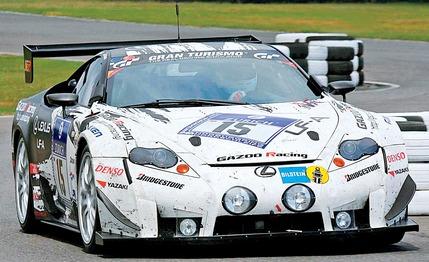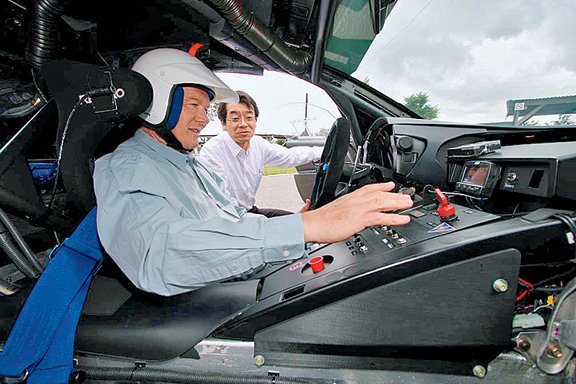 Preview
Preview
It seems like forever since Lexus’s LF-A concept, the company’s first supercar, debuted at the Detroit auto show in 2005, but Toyota says it has taken the five years to meticulously develop the prototype (code-named P280) into a production-ready car. According to Toyota, the wait will end in the spring of 2010.
Which is why we felt compelled to ask LF-A chief engineer Haruhiko Tanahashi: “Hey, what took so long?” Tanahashi stared high into the sky and, after a long silence, replied carefully, “Everything on this project is new for us. The front mid-engine package, the technical solutions, like the F1-inspired V-10 and the lightweight materials. We wanted to make it an uncompromised sports car.”
Toyota’s president, Akio Toyoda, was so deeply involved in the project that he raced the concept car—under the pseudonym “Morizo”—with three others at the 24-hour endurance race at the sprawling Nürburgring ractrack in May. A Toyota technician let slip that the race in Germany was part of final testing before the car graduated to production. When it arrives, the $250,000 LF-A will have to duke it out with the far less expensive (by about $170,000) Nissan GT-R for the title of ultimate Japanese supercar. But on the admittedly race-ready version we drove for this story, the handling is even more responsive and direct than the GT-R’s.
Turning the ignition key fills the carbon-fiber composite structure and aluminum body panels with an angry bark from the engine. A push of the throttle gives voice to a car that seems impatient to prove itself after the long wait.
Mounted low in the chassis, thanks in part to a dry-sump lubrication system, is an all-aluminum 4.8-liter V-10 with a cylinder-bank angle of 72 degrees. Lightweight materials for the pistons and the valvetrain give the engine the rev-happy nature of a racing mill. The 175.2-inch-long two-seat supercar is 73.2 inches wide and only 48.4 inches high. Its 101.6-inch wheelbase is 9.1 inches longer than the Porsche 911 Turbo’s, but its claimed curb weight of less than 3300 pounds is nearly 220 pounds lighter than the Porsche’s.
__________________________________________________________________________________

Road unready: Lexus’s first supercar in race-ready trim.
__________________________________________________________________________________
“So, what else can you tell us about the engine, Mr. Tanahashi?” The chief engineer shrugged, peered up to the sky once more, and was again silent.
Our guess is that the V-10 has been heavily inspired by the 3.0-liter V-10 residing in Toyota’s previous Formula 1 race car. Note: Ferrari, Renault, and Toyota build both their own F1 car and its engine.
We try a more specific question: “How much horsepower can we expect?”
Tanahashi forgets the sky and looks our way: “Over 500 horsepower.” This is his last comment of the day.
In the car, the engine feels stronger than 500 horsepower, more like 550. A Lexus spokesman provides a torque figure: 369 pound-feet. We are taken by the quickness of the throttle’s response, especially when the engine is revved past 4200 rpm. Max engine speed is nearly 9000 rpm. The exhilarating responsiveness feels similar to the Porsche GT3’s 3.8-liter flat-six and even reminds us of the Ferrari Enzo. A blast from standstill, with a glance at a stopwatch, suggests a 0-to-60-mph time of about 3.5 seconds, putting the LF-A comfortably into supercar territory. Accelerating out of corners, the car stays planted and is easy to control, thanks to a Torsen-type limited-slip differential and electronic traction control.
When the LF-A hits public roads next year, it will be equipped with ceramic brakes with six-piston calipers in front and four-piston units in the rear. The Nürburgring car was equipped with conventional steel brakes to meet race regulations.
The LF-A picks up speed amazingly fast, as if shot from a sling. A nonvariable rack-and-pinion steering system results in precise turn-in, and if any body roll exists, we didn’t detect it. With the engine set behind the front-axle line, the weight distribution comes in at a nearly balanced 49 percent in the front and 51 in the back. Even by changing gears in corners to provoke the chassis, the LF-A remains easy to control. Gearchanges are handled by paddles behind the steering wheel that connect to the Toyota-designed, six-speed automated manual.
The exterior design of the production LF-A will not change, but the aerodynamic aids of the race car we drove will disappear. When it comes to market, the LF-A will get a speed-sensitive rear spoiler, LED taillamps, and bixenon headlights.
We’re told the project has caused controversy at Toyota. The LF-A certainly doesn’t fit with the company’s desire to be viewed as a green automaker. And it seems awfully sporty for conservative Toyota. However, a company engineer confirmed two years ago at the Geneva show that the carbon-fiber structure of the LF-A could be easily adapted to house an electric motor and perhaps even a gasoline-hybrid drivetrain. LF-Ah, anyone?